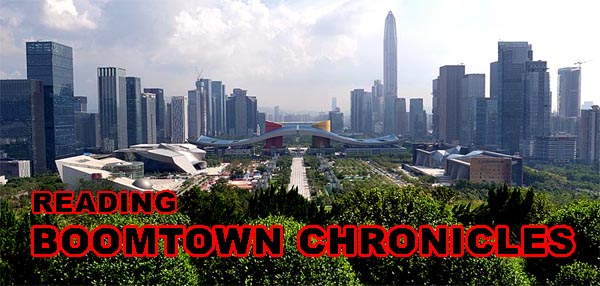 |
| Shenzhen, the Boomtown (Wikipedia) |
Note: Between Lesson #01-128 and #01-208, I wrote 72 lessons explaining expressions in articles published in the Shenzhen Daily. Read more about "Reading Boomtown Chronicles."
Get Ready: What is the topography like where you live?
Boomtown Chronicles Part XXI - published Monday, November 17, 2008 (cont.)
Grammar point: When I saw the word "shrimps" in the article, I thought it was a mistake. I thought the plural of "shrimp" could only be "shrimp," as with "deer" and "sheep." But I was wrong: both "shrimp" and "shrimps" are acceptable plurals for the word "shrimp." Live and learn!
- The Shenzhen River has "paid the price of a booming economy..."
pay the price for something: to suffer the consequences for something. For example, a person who stays out drinking all night "pays the price" the next day when he has to go to work with a headache and an upset stomach.
- The river was once called the "'Ming River,' which means a limpid river..."
limpid: clear. It comes from Limpa, the name of a Latin water goddess, so water, too, was called limpa. Because water is a good example of something that is clear, the word came to mean "clear," changing to the form "limpida." From this we get the English "limpid."
"Lymph," the clear, water-like liquid that is found throughout the human body, also comes from the word "limpa." And, oddly, both "Ming" and "Qing," the names of China's last two dynasties, can be translated "limpid."
- The river became less limpid due to "the red-hot pace of economic development..."
red hot: very rapid. "Hot" sometimes means "fast" or "exciting," as when you run fast and become hot. "Red-hot" brings to mind metal work: put a piece of iron in a fire and as it heats up it will turn bright red.
- The article discusses a change in the riverside topography.
topography: the science of map making. topo- comes from topos, meaning "place." We see this in the term "utopia," meaning "a perfect place," as in "Shangri-La is a utopia." However, Thomas More, the man who coined the term, made a little joke: This u- means "no" (like "un-"), so "utopia" really means "no place." -graphy means "writing." Technically, the first meaning of "topography" is the science of map making: writing down places. By extension, though, we use it to mean the features that are written down, such as valleys, hills, rivers, and so on.
--------
Read more: https://en.wikipedia.org/wiki/Shenzhen
Practice: Choose the correct term to fill in the blank in the sentence below:
- limpid
- lymph
- pay the price
- red hot
- shrimp
- topography
- The cop chased the gunman into an abandoned building in a ________ pursuit.
- If you want to be successful, you're going to have to ________.
- He couldn't look away from her ________ blue eyes.
- She looked with fascination at the ________ as viewed from the airplane.
- He enjoyed crabs, ________, and other kinds of seafood.
- One of the functions of ________ is to help fight infection.
Answers are in the first comment below.
Submitted to the Shenzhen Daily for November 27, 2008


Answers to the Practice: 1. c; 2. f; 3. b; 4. a; 5. e; 6. d
ReplyDelete